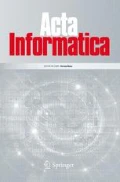Abstract
The aim of this study is to understand the inherent expressive power of CTL operators. We investigate the complexity of model checking for all CTL fragments with one CTL operator and arbitrary Boolean operators. This gives us a fingerprint of each CTL operator. The comparison between the fingerprints yields a hierarchy of the operators that mirrors their strength with respect to model checking.

















Similar content being viewed by others
References
Alur, R., Henzinger, T.A., Kupferman, O.: Alternating-time temporal logic. J. ACM 49(5), 672–713 (2002). https://doi.org/10.1145/585265.585270
Bauland, M., Mundhenk, M., Schneider, T., Schnoor, H., Schnoor, I., Vollmer, H.: The tractability of model checking for LTL: the good, the bad, and the ugly fragments. TOCL 12(2), 26 (2011)
Bauland, M., Schneider, T., Schnoor, H., Schnoor, I., Vollmer, H.: The complexity of generalized satisfiability for linear temporal logic. LMCS 5(1), 1–21 (2009)
Beyersdorff, O., Meier, A., Mundhenk, M., Schneider, T., Thomas, M., Vollmer, H.: Model checking CTL is almost always inherently sequential. LMCS 7(2), 1–21 (2011)
Böhler, E., Creignou, N., Reith, S., Vollmer, H.: Playing with boolean blocks, part I: Post’s lattice with applications to complexity theory. SIGACT 34(4), 38–52 (2003)
Chandra, A.K., Kozen, D., Stockmeyer, L.J.: Alternation. J. ACM 28, 114–133 (1981)
Chandra, A.K., Tompa, M.: The complexity of short two-person games. Discrete Appl. Math. 29(1), 21–33 (1990)
Clarke, E., Emerson, E.A., Sistla, A.P.: Automatic verification of finite-state concurrent systems using temporal logic specifications. TOPLAS 8(2), 244–263 (1986)
Clarke, E.M., Emerson, E.A.: Design and synthesis of synchronisation skeletons using branching time temporal logic. In: Logic of Programs, LNCS, vol. 131, pp. 52–71. Springer (1981)
Cook, S.A.: A taxonomy of problems with fast parallel algorithms. Inf. Control 64(1–3), 2–21 (1985)
Emerson, E.A., Halpern, J.Y.: “Sometimes” and “not never” revisited: on branching versus linear time. J. ACM 33(1), 151–178 (1986)
Emerson, E.A., Jutla, C.S.: The complexity of tree automata and logics of programs. SIAM J. Comput. 29(1), 132–158 (2000)
Fischer, M.J., Ladner, R.E.: Propositional modal logic of programs. JCSS 18, 194–211 (1979)
Immerman, N.: Number of quantifiers is better than number of tape cells. J. Comput. Syst. Sci. 22(3), 384–406 (1981)
Krebs, A., Meier, A., Mundhenk, M.: The model checking fingerprints of CTL operators. In: Grandi, F., Lange, M., Lomuscio, A. (eds.) 22nd International Symposium on Temporal Representation and Reasoning, TIME 2015, Kassel, Germany, pp. 101–110. IEEE (2015)
Kupferman, O., Sattler, U., Vardi, M.Y.: The complexity of the graded \(\mu \)-calculus. In: Voronkov, A. (ed.) 18th International Conference on Automated Deduction (CADE) Copenhagen, Denmark, pp. 423–437. Springer (2002)
Laroussinie, F.: About the expressive power of CTL combinators. IPL 54(6), 343–345 (1995)
Meier, A.: On the complexity of modal logic variants and their fragments. Ph.D. thesis, Leibniz Universität Hannover, Institut für Theoretische Informatik (2011)
Meier, A., Müller, J.S., Mundhenk, M., Vollmer, H.: Complexity of model checking for logics over Kripke models. Bull. EATCS 108, 50–89 (2012)
Meier, A., Mundhenk, M., Thomas, M., Vollmer, H.: The complexity of satisfiability for fragments of CTL and \(\text{ CTL }^*\). IJFCS 20(05), 901–918 (2009)
Meier, A., Mundhenk, M., Thomas, M., Vollmer, H.: Erratum: The complexity of satisfiability for fragments of CTL and \({\text{ CTL }}^*\). Int. J. Found. Comput. Sci. 26(8), 1189 (2015). https://doi.org/10.1142/S012905411592001X
Mundhenk, M., Weiß, F.: The complexity of model checking for intuitionistic logics and their modal companions. In: Proceedings of RP’10, LNCS, vol. 6227, pp. 146–160. Springer (2010)
Mundhenk, M., Weiß, F.: An AC\(^1\)-complete model checking problem for intuitionistic logic. Comput. Complex. 23(4), 637–669 (2014)
Papadimitriou, C.H.: Computational Complexity. Addison-Wesley, Reading (1994)
Pnueli, A.: The temporal logic of programs. In: Proceedings of 18th FOCS, pp. 46–57. IEEE Computer Society Press (1977)
Post, E.: The two-valued iterative systems of mathematical logic. Ann. Math. Stud. 5, 1–122 (1941)
Pratt, V.R.: A near-optimal method for reasoning about action. JCSS 20(2), 231–254 (1980)
Prior, A.N.: Time and Modality. Clarendon Press, Oxford (1957)
Prior, A.N.: Past, Present, and Future. Clarendon Press, Oxford (1967)
Schnoebelen, P.: The complexity of temporal logic model checking. In: AiML, pp. 393–436. King’s College Publications (2002)
Vardi, M.Y., Stockmeyer, L.: Improved upper and lower bounds for modal logics of programs: preliminary report. In: STOC ’85, LNCS, pp. 240–251 (1985)
Vardi, M.Y., Stockmeyer, L.: Lower bound in full (2EXPTIME-hardness for \(\text{ CTL }^*\)-SAT). http://www.cs.rice.edu/~vardi/papers/ctl_star_lower_bound.pdf (1985). Accessed 31 July 2018
Author information
Authors and Affiliations
Corresponding author
Additional information
Andreas Krebs acknowledges support by the German Research Foundation DFG Project KR 4042/2. Arne Meier acknowledges support by the German Research Foundation DFG Project ME 4279/1-1.
Rights and permissions
About this article
Cite this article
Krebs, A., Meier, A. & Mundhenk, M. The model checking fingerprints of CTL operators. Acta Informatica 56, 487–519 (2019). https://doi.org/10.1007/s00236-018-0326-9
Received:
Accepted:
Published:
Issue Date:
DOI: https://doi.org/10.1007/s00236-018-0326-9




